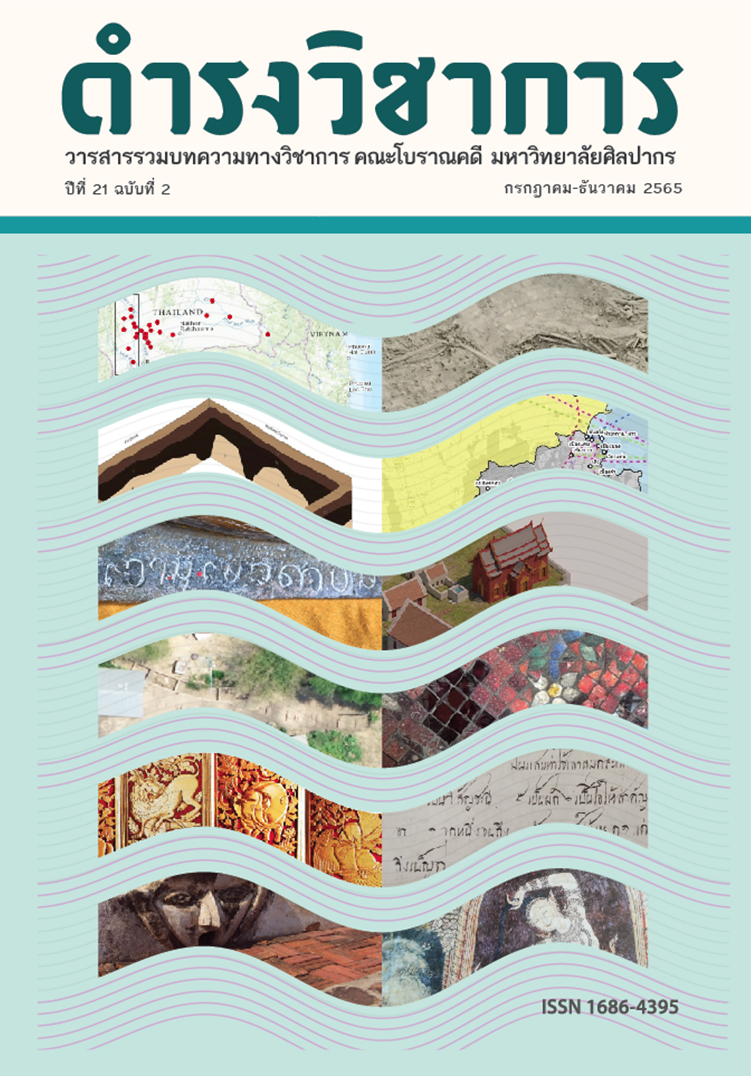Phualkon’s Residence at Lopburi, 1683-1688: A Visual Reconstruction
Keywords:
Phaulkon’s residence, visual reconstruction, Notre-Dame de Laurette, LopburiAbstract
This paper draws from my research entitled A Visual Reconstruction of Phualkon’s Residence, examining its transformation between 1683, when he moved to live in this house, and 1688, when he was executed. The main events of this period were Phaulkon’s rise to high office at the Court of King Narai, the arrival of the French Embassy to Narai’s court, and the 1688 revolution led by Phetracha. The question is how far the physical ruins of Phaulkon’s residence and its development can reflect the last episode of Phualkon’s life. The research draws upon travellers' memoirs, excavation reports, and first-hand analysis by architectural measurement and visual inspection of the ruins. The findings suggest that the development of the house can be divided into three phases. The first phase is pre-1683, when the house belonged to a Persian merchant in the service of King Narai before Phaulkon moved to the house. The second phase spans 1683 to 1685, which concerns the conversion and extension of the house both for Phaulkon's use and for receiving the 1st French Embassy to Siam headed by Chevalier de Chaumont. The third phase between 1685 and 1688 involved the 2nd French Embassy to Siam led by La Loubère in 1687 until the 1688 revolution. The conclusion drawn is that the last five years of the house’s development reflects Phaulkon’s roles as King Narai’s closest counsellor and as the leader of foreign communities in Siam. The findings show that the architecture in Phaulkon’s residence consisted of a variety of artistic and architectural styles of different origins, ranging from Moorish, King Narai’s style, to Gothic, including Japanese painting and the use of precious stones from India. The hybridized characteristics are another important element that reflects the multiculturism of Ayutthaya society during the reign of King Narai.
References
เอกสารชั้นต้นที่ไม่ได้ตีพิมพ์
“จดหมายหลวงบริบาลบุรีภัณฑ์ ถึงนายเชย ชมเสวก.”, พ.ศ. 2475. เอกสารกระทรวงศึกษาธิการ. ศธ 2.1.1/309. สำนักหอจดหมายเหตุแห่งชาติ.
“ส่งรายงานประมาณการซ่อมโบราณสถาน จ. ลพบุรี.”, พ.ศ. 2472. เอกสารกระทรวงศึกษาธิการ. (4) ศธ 2.1.2.1/66. สำนักหอจดหมายเหตุแห่งชาติ.
ภาษาไทย
ชิดชนก ถิ่นทิพย์, 2564. รายงานการขุดแต่งทางโบราณคดี โบราณสถานบ้านหลวงรับราชทูต (บ้านวิชาเยนทร์) ตำบลท่าหิน อำเภอเมืองลพบุรี จังหวัดลพบุรี. ม.ป.ท.: บริษัท อมรพัฒน์ บูรณะ จำกัด, สนับสนุนทุนสำรวจโดย สำนักศิลปากรที่ 4 ลพบุรี ปีงบประมาณ 2564.
เซเบเรต์, โคลด์, 2560. จดหมายเหตุของมองซิเออร์เซเบเรต์. (แปลโดย ราชบัณฑิตยสภา). นนทบุรี: ศรีปัญญา. (ต้นฉบับพิมพ์เมื่อ ค.ศ. 1687, ภาษาฝรั่งเศส).
เดอ ชัวซีย์, บาทหลวง, 2550. จดหมายเหตุรายวันการเดินทางไปสู่ประเทศสยามในปี ค.ศ. 1685 และ 1686 ฉบับสมบูรณ์. (แปลโดย สันต์ ท. โกมลบุตร). พิมพ์ครั้งที่ 2. นนทบุรี: ศรีปัญญา. (ต้นฉบับพิมพ์เมื่อ ค.ศ. 1687, ภาษาฝรั่งเศส).
เดอ แบส, บาทหลวง, 2550. บันทึกความทรงจำของบาทหลวง เดอะ แบส เกี่ยวกับชีวิตและมรณกรรมของก็องสตังซ์ ฟอลคอน. (แปลโดย สันต์ ท. โกมลบุตร). นนทบุรี: ศรีปัญญา. (ต้นฉบับพิมพ์เมื่อ ค.ศ. 1691, ภาษาฝรั่งเศส).
ตาชารด์, กีย์, 2551. จดหมายเหตุการเดินทางสู่ประเทศสยามครั้งที่ 1 และจดหมายเหตุการเดินทางครั้งที่ 2. (แปลโดย สันต์ ท. โกมลบุตร). นนทบุรี: ศรีปัญญา. (ต้นฉบับพิมพ์เมื่อ ค.ศ. 1688, ภาษาฝรั่งเศส).
นงคราญ ศรีชาย, 2537. “บ้านวิชาเยนทร์และบ้านหลวงรับราชทูต.” เมืองโบราณ 20 (4): 31-41.
นิธิ เอียวศรีวงศ์, 2537. การเมืองไทยสมัยพระนารายณ์. พิมพ์ครั้งที่ 3. กรุงเทพฯ: มติชน.
เลอบล็องก์, มาร์เซล, 2552. “ประวัติศาสตร์การปฎิวัติของราชอาณาจักรสยาม.” ใน การอ่านเอกสารประวัติศาสตร์ไทย : ตัวอย่างเอกสารต่างชาติ. (แปลโดย จันทร์ฉาย ภัคอธิคม). กรุงเทพฯ: ภาควิชาประวัติศาสตร์ คณะมนุษยศาสตร์ มหาวิทยาลัยรามคำแหง. (ต้นฉบับพิมพ์เมื่อ ค.ศ. 1692, ภาษาฝรั่งเศส).
สมคิด จิระทัศนกุล, 2546. คติ สัญลักษณ์ และความหมายของซุ้มประตู-หน้าต่างไทย. กรุงเทพฯ: อัมรินทร์พริ้นติ้งแอนด์พับลิชชิ่ง.
สฤษดิ์พงศ์ ขุนทรง, 2549. “บ้านวิชาเยนทร์: การขุดค้นทางโบราณคดีครั้งล่าสุด.” เมืองโบราณ 32 (4): 16-17.
สุภรณ์ อัศวสันโสภณ, ผู้แปล, 2522. บันทึกเรื่องสัมพันธภาพระหว่างกรุงสยามกับนานาประเทศในคริสตศตวรรษที่ 17 เล่ม 3. กรุงเทพฯ: กรมศิลปากร.
อชิรัชญ์ ไชยพจน์พานิช, 2555. พัฒนาการของงานศิลปกรรมเมืองลพบุรีตั้งแต่พุทธศตวรรษที่ 12 ถึงพุทธศตวรรษที่ 24. นครปฐม: สถาบันวิจัยและพัฒนา มหาวิทยาลัยศิลปากร.
ภาษาต่างประเทศ
Baker C. & Phongpaichit P., 2017. A history of Ayutthaya: Siam in the early modern world. Cambridge: Cambridge University Press.
Desfarges, De La Touche & Vollant des Verquains J., 2002. Three military accounts of the 1688 "revolution" in Siam. (Translated by M. Smithies). Bangkok: Orchid Press.
Hutchinson E.W., 1935. “Phaulkon's house at Lopburi.” Journal of Siam Society XXVII: 1-7.
Listopad J.A., 1995. “The art and architecture of the reign of Somdet Phra Narai.” Doctoral dissertation (History of Art). The University of Michigan.
Love R.S., 2006. “Royal protocal and cultural synthesis in the preparation for the Chevalier de Chaumont’s embassy to Siam in 1685.” Journal of the Western Society for French History 34: 1-26.
ข้อมูลอิเล็กทรอนิกส์
จอมเกล้าเจ้าอยู่หัว, พระบาทสมเด็จพระ, 2561. ชุมนุมพระบรมราชาธิบายในพระบาทสมเด็จพระจอมเกล้าเจ้าอยู่หัว ภาคที่ 4 หมวดโบราณสถาน 211 ต้นประกาศพระราชทานแลกเปลี่ยนที่วิสุงคามสีมาเมืองลพบุรี. ค้นเมื่อ 2 พฤษภาคม 2561, จาก http://vajirayana.org
Chaumont A., 1687. A relation of the embassy of Monr. de Chaumont, Knt. to the count of the King of Siam with an account of the government, state, manners, religion and commerce of that kingdom. Retrieved February 2, 2018, from http://tei.it.ox.ac.uk/tcp/Texts-HTML/free/A32/A32752.html
Downloads
Published
Issue
Section
License
Copyright (c) 2022 Damrong Journal of The Faculty of Archaeology Silpakorn University

This work is licensed under a Creative Commons Attribution-NonCommercial-NoDerivatives 4.0 International License.
บทความนี้เป็นผลงานของข้าพเจ้าแต่เพียงผู้เดียว และ/หรือเป็นผลงานของข้าพเจ้าและผู้ร่วมงาน ตามชื่อที่ระบุในบทความจริง และเป็นผลงานที่มิได้ถูกนำเสนอหรือตีพิมพ์ที่ใดมาก่อน





